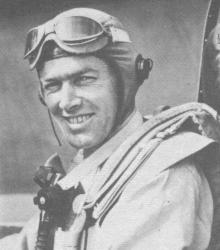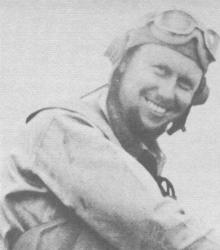| Battle of the Coral Sea | |||
| Home Page | Airmen Index | ||
 |
 | ||
|---|---|---|---|
| Lt. James Flatley | Lt. Stanley "Swede" Vejtasa | ||
| Lt. Noel Gayler, Cmdr. Bob Dixon, and Lt. John Leppla | |||
|
By late April, 1942, the first important sea
battle between American and Japanese forces was
shaping up. In March, planes from the Enterprise
had hit Japanese-occupied Wake Island, and the
Lexington, teamed with the Yorktown, to strike enemy
bases at Lae and Salamaua on New Guinea, a
large island just off the northern coast of Australia.
Intelligence reports indicated that the Japanese were planning to invade Port Moresby, near the eastern tip of New Guinea. The enemy task force intended to sail around this eastern tip, into the Coral Sea, and then attack. Port Moresby was vital to Allied strategy. From it, the USA based its campaign in New Guinea. If Port Moresby were lost, Australia would be threatened. To ward off the threat, the Lexington and Yorktown were ordered into the Coral Sea, to intercept the invaders. At 10:30 a.m. on May 5th, the two carriers heard a report from Lieutenant Commander James Flatley, who led the Yorktown's fighters. He was flying on Combat Air Patrol (CAP), and had spotted a Kawanishi flying boat spying on the task force. "Where is he?" the Lexington wanted to know. "Wait a minute and I'll show you," radioed Flatley. Suddenly there was an explosion, and a great ball of fire tumbled from the clouds. It was the Kawanishi falling. Jimmy Flatley's guns had scored a hit. On its way down, the big plane almost struck Lieutenant Noel Gayler's Wildcat. Gayler was off the Lexington. "Hey, Jimmy," he yelled, "that one almost hit me." "That'll teach you to fly underneath me when Japs are around," Flatley quipped. As a matter of fact, Flatley was "around" only by chance himself. A few days before, he had been ordered back to the States to form a new fighter squadron, but he managed to get permission to stay for the coming battle. On the morning of May 7th, a scout from the Lexington reported an enemy carrier, the Shoho, 180 miles away. Ninety-three planes--dive bombers, torpedo planes and fighters--were sent to the attack. In less than an hour, US planes found the Shoho and her escorts, and the first bombers were nosing over into screaming dives from an altitude of 15,000 feet. Within a half hour the Shoho was a sinking inferno. The men on the Lexington heard an excited report from Commander Bob Dixon in one of the scout bombers over the target, "Scratch one flattop!" American fliers had sunk the first carrier to be lost by either side. As a matter of fact, it was the first important warship US forces had destroyed. Later that same day, four Wildcats from both the Lexington and the Yorktown attacked a formation of nine Zeros flying overhead, and shot down seven of them. In this fight Jimmy Flatley got three. That night there occurred one of the strangest incidents of the war at sea. In the darkness, a formation of Japanese bombers tried to land on the Lexington, mistaking it for one of their own carriers. Immediately the Lexington's guns came to life, and red tracers crisscrossed through the night. Eleven of the bombers crashed into the sea. Actually their own fleet was only thirty miles away. Just after dawn on the following day, two Japanese carriers--the Shokaku and the Zuikaku--were sighted. Immediately the United States carriers launched seventy-three aircraft. Lieutenant Noel Gayler was one of the fighter pilots escorting a flight of old Douglas TBD "Devastator" torpedo planes. He and three other pilots from the Lexington tore into the screen of Zeros, protecting the Japanese carriers. The American fliers were heavily outnumbered but their courageous attack allowed the slow torpedo planes to get through. Gayler destroyed two of the Zeros and the other Wildcat pilots got one each. But only Gayler survived the fight. On his way back to the Lexington, Gayler discovered two Kawanishi flying boats in his path. With the last of his ammunition, he shot them both down. Gayler was now the Navy's top ace with eight victories. In the meantime, Japanese planes had found the American carriers. Unfortunately, most of the fleet's Wildcats were miles away, escorting American bombers, so Lieutenant Stanley "Swede" Vejtasa's squadron of Douglas SBD "Dauntless" dive bombers, were pressed into service to replace the missing fighter planes. They had to do their best to protect the Lexington and Yorktown. The Dauntless was at least 100 miles an hour slower than the Zero, and had only two forward firing guns. At 11:14 a.m., Vejtasa's six planes were jumped by twelve Zeros. Two Dauntlesses fell flaming into the water. Vejtasa managed to escape the first attack and yelled to his radio man: "Son, we're in for a scrap. Keep your head and conserve your ammunition.... I'll take care of the rest." As the Zeros closed in again, Swede Vejtasa fought with the skill of a born fighter pilot. His rear gunner kept the swift Zeros off his flanks, while Vejtasa calmly leveled his sights at the Japanese fighters coming head on for the steady Dauntless. Again and again--three times--he maneuvered the scout bomber so that its two forward-firing guns ripped into a Zero. Three times a surprised Japanese pilot found himself spinning into the Coral Sea. Another Dauntless pilot was proving he could handle the Zero too. Lieutenant John Leppla who, with his gunner D. K. Liska, had flamed four Japanese planes the day before during the bombing attack on the carrier Shoho, now put his newfound talent to work again. Without hesitation, Leppla sent his Dauntless plunging into the deadly enemy torpedo planes heading for the Lexington. Not only did Leppla send three of these Japanese bombers careening into the water below, he also saved the life of a fellow Dauntless pilot by a daring attack on a Zero, about to shoot down the American. (Later Commander Flatley picked outstanding bomber pilots like Swede Vejtasa and John Leppla, to form his new fighter group, which would be named the "Grim Reapers.") All in all it was quite a day in the air. On the sea it was another matter. American planes had again broken through the Japanese fighter defenses and seriously damaged a second carrier, but the enemy planes had penetrated the weak Wildcat/Dauntless screen too. The Lexington, hit with five torpedoes, was doomed. The Yorktown was pounded by Japanese dive bombers, but her crew successfully fought the resulting fires. Tactically, the Battle of the Coral Sea was almost a draw. In fact, you could say the United States lost it if you simply compared the number of ships sunk or damaged on each side. But the Japanese were forced to turn back from Port Moresby, and that was the important thing at the moment. It was also the first major fight at sea in which the ships involved, neither saw nor shot at each other. As the gallant Lexington began to sink, her crew was ordered to abandon her. Hundreds of men were already in the water when Noel Gayler decided he had better get off too. He jumped fifty feet into the sea, and then some time later was seen climbing back up a rope to the flight deck of the badly listing ship. Dripping wet, he stood calmly in front of a few of the nervous fighter pilots still aboard. One of them asked him, "What did you come back for?" Gayler's answer showed, if nothing else, his calmness in battle. "Oh, I got a bit lonely out there," he said. "I didn't know any of those guys. When are you fellows going to come?" |
© The Aviation History On-Line Museum. 2006 All rights reserved.